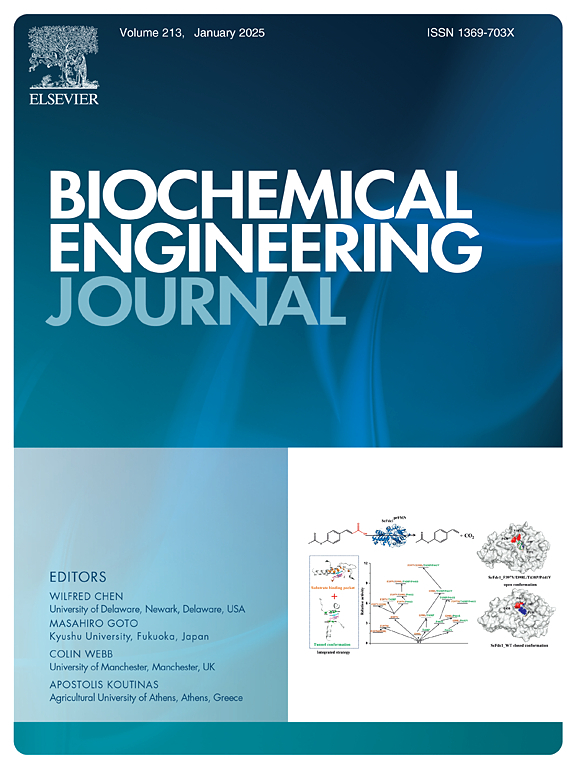CFD-guided scaling of Pseudomonas putida fermentation
IF 3.7
3区 生物学
Q2 BIOTECHNOLOGY & APPLIED MICROBIOLOGY
引用次数: 0
Abstract
This study evaluated the scale-up of Pseudomonas putida fed-batch fermentation from a 2 L benchtop-scale stirred bioreactor to a 200 L pilot-scale tank by using a validated computational fluid dynamic (CFD) model. One of the major concerns in this fermentation process is the potential reduction in mixing quality with increasing scale, leading to lower yield or product quality. For a low-risk scale-up, a multiphase Euler-Euler CFD model was developed that simulated the hydrodynamics of the fed-batch system at various filling volumes, representing different stages of the fermentation process. The model was validated using experimental data of mixing time and mass transfer coefficient. The hydrodynamic model was then coupled with a Monod kinetic model of P. putida ‘s fermentation. Response surface methodology was used to generate a performance map of the pilot bioreactor at various aeration, agitation, and bioreactor filling volumes. The study considered different established scale-up approaches, such as constant tip speed and aeration rate across scales, constant , as well as constant power to unit of liquid volume (P/V). The performance of the bioreactor was assessed, and the optimum operating ranges of the input parameters were obtained at different stages of the fermentation. Using performance map the possibility of substrate and oxygen gradient formation, and the gradient severity inside the pilot bioreactor at different working volumes were evaluated.
以 CFD 为指导的假单胞菌发酵规模化
本研究通过使用经过验证的计算流体动力学(CFD)模型,评估了从 2 升台式搅拌生物反应器到 200 升中试规模罐的假单胞菌给料批次发酵的放大。这种发酵工艺的一个主要问题是,随着规模的扩大,混合质量可能会降低,从而导致产量或产品质量下降。为了实现低风险放大,开发了一个多相欧拉-欧拉 CFD 模型,该模型模拟了代表发酵过程不同阶段的不同填充量下的进料批次系统的流体动力学。利用混合时间和传质系数的实验数据对模型进行了验证。然后将流体动力学模型与普氏菌发酵的莫诺动力学模型相结合。采用响应面方法生成了中试生物反应器在不同通气量、搅拌量和生物反应器填充量下的性能图。该研究考虑了不同的既定放大方法,如不同规模的恒定尖端速度和曝气速率、恒定 kLa 以及单位液体体积的恒定功率 (P/V)。对生物反应器的性能进行了评估,并得出了发酵不同阶段输入参数的最佳运行范围。利用性能图评估了基质和氧气梯度形成的可能性,以及不同工作容积下中试生物反应器内的梯度严重程度。
本文章由计算机程序翻译,如有差异,请以英文原文为准。
求助全文
约1分钟内获得全文
求助全文
来源期刊

Biochemical Engineering Journal
工程技术-工程:化工
CiteScore
7.10
自引率
5.10%
发文量
380
审稿时长
34 days
期刊介绍:
The Biochemical Engineering Journal aims to promote progress in the crucial chemical engineering aspects of the development of biological processes associated with everything from raw materials preparation to product recovery relevant to industries as diverse as medical/healthcare, industrial biotechnology, and environmental biotechnology.
The Journal welcomes full length original research papers, short communications, and review papers* in the following research fields:
Biocatalysis (enzyme or microbial) and biotransformations, including immobilized biocatalyst preparation and kinetics
Biosensors and Biodevices including biofabrication and novel fuel cell development
Bioseparations including scale-up and protein refolding/renaturation
Environmental Bioengineering including bioconversion, bioremediation, and microbial fuel cells
Bioreactor Systems including characterization, optimization and scale-up
Bioresources and Biorefinery Engineering including biomass conversion, biofuels, bioenergy, and optimization
Industrial Biotechnology including specialty chemicals, platform chemicals and neutraceuticals
Biomaterials and Tissue Engineering including bioartificial organs, cell encapsulation, and controlled release
Cell Culture Engineering (plant, animal or insect cells) including viral vectors, monoclonal antibodies, recombinant proteins, vaccines, and secondary metabolites
Cell Therapies and Stem Cells including pluripotent, mesenchymal and hematopoietic stem cells; immunotherapies; tissue-specific differentiation; and cryopreservation
Metabolic Engineering, Systems and Synthetic Biology including OMICS, bioinformatics, in silico biology, and metabolic flux analysis
Protein Engineering including enzyme engineering and directed evolution.
 求助内容:
求助内容: 应助结果提醒方式:
应助结果提醒方式:


